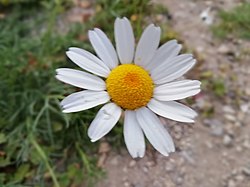Argyranthemum frutescens
| Argyranthemum frutescens | |
|---|---|

| |
| Scientific classification | |
| : | [[Template:Taxonomy/Argyranthemum]] |
| Species: | Template:Taxonomy/ArgyranthemumA. frutescens
|
| Binomial name | |
| Template:Taxonomy/ArgyranthemumArgyranthemum frutescens | |
| Synonyms[1] | |
|
Synonymy
| |
Argyranthemum frutescens, known as Paris daisy,[2] marguerite or marguerite daisy, is a perennial plant known for its flowers. It is native to the Canary Islands (part of Spain).[3] Hybrids derived from this species (garden marguerites) are widely cultivated as ornamental plants in private gardens and public parks in many countries, and have naturalized in Italy[4] and southern California.[5] There are many cultivars, but the most common has white petals.[6][failed verification]
Description[edit | edit source]
It is a perennial shrub that grows to about 20–80 cm (7.9–31.5 in). The strongly branched plant often grows globose-bushy with ascending to upright branches. The alternate, more or less fleshy and blue-green leaves are in outline oval to oval-lanceolate, 1–8 cm (0.4–3.1 in) long and 4–6 cm (1.6–2.4 in) wide. The foliage is green. The inflorescences are loose with 4 to 30 daisy-like flower heads, white with a yellow center, up to 2 cm (0.79 in) in diameter.[7]
In most subspecies, the ligules of the ray florets are about 8 mm long, pure white, female and form fertile achenes, which are triangular to horn-like winged. The achenes of the yellow tubular central flowers are sterile and one-winged. The pappus is always irregularly crown-shaped. The flower is very fragrant. The flower opens its petals in the morning and closes them at night.[8]
Subspecies[edit | edit source]
List:[1]
- Argyranthemum frutescens subsp. canariae (Christ) Humphries
- Argyranthemum frutescens subsp. foeniculaceum (Pit. & Proust) Humphries
- Argyranthemum frutescens subsp. frutescens
- Argyranthemum frutescens subsp. gracilescens (Christ) Humphries
- Argyranthemum frutescens subsp. pumilum Humphries
Distribution and habitat[edit | edit source]
Like the other Argyranthemum species, the shrub marguerite originates from the Canary Islands. On El Hierro, La Gomera, Tenerife and Gran Canaria it is common in the coastal regions, on La Palma very rare. Overall, it is the most common species of the genus in the Canary Islands. The plant often grows in succulent shrubbery on well-drained, poor soils in full sun, preferably also near the coast at altitudes up to 700 meters.
Along with full sunlight, this plant needs organic matter in high quantities in order to grow, while it also requires very well drained soil. The plant can die if overwhelmed with water. It is tolerant of low temperatures, although it cannot survive freezing. It requires a lot of sunlight and must be protected from the wind.[9]
Cultivation[edit | edit source]
Argyranthemum frutescens subsp. canariae has been given the Award of Garden Merit (AGM) by the Royal Horticultural Society.[10] Many of the plants grown under the name "Argyranthemum frutescens" are cultivars of garden marguerites, some being hybrids between this species and related genera. The cultivars produce prolific single or double-flowered daisy-like flowers in shades of white, pink, yellow and purple throughout summer.[11] In the UK climate, they are generally half-hardy, and can be grown from seed or cuttings, or purchased as young plants to be planted out after all danger of frost has passed.[12]
See also[edit | edit source]
- Leucanthemum, similar looking plant of different genus
References[edit | edit source]
- ↑ 1.0 1.1 The Plant List Argyranthemum frutescens (L.) Sch.Bip.
- ↑ Template:BSBI 2007
- ↑ Humphries, C. J. 1976. A revision of the Macaronesian genus Argyranthemum Webb ex Schultz Bip. (Compositae–Anthemideae). Bull. Br. Mus. (Nat. Hist.), Bot. 5: 147–240.
- ↑ Altervista Flora Italiana Margherita delle Canarie, Argyranthemum frutescens (L.) Sch. Bip.
- ↑ Biota of North America Program 2014 county distribution map
- ↑ Calflora taxon report, University of California, Argyranthemum frutescens (L.) Schultz-Bip. marguerite
- ↑ Bramwell, David & Bramwell, Zoë (2001). "Argyranthemum frutescens". Wild Flowers of the Canary Islands (2nd ed.). Madrid: Editorial Rueda. p. 338. ISBN 978-84-7207-129-2.
- ↑ Hohenester, Adalbert and Welß, Walter: excursion flora for the Canary Islands . Publisher Eugen Ulmer 1993, ISBN 3-8001-3466-7.
- ↑ Gordon Cheers (ed.): Botanica . Random House Australia 2003. German edition: Tandem Verlag GmbH 2003, ISBN 3-8331-1600-5 .
- ↑ " Argyranthemum frutescens subsp. canariae", Plant finder & selector / RHS Gardening, The Royal Horticultural Society, 2020, retrieved 2012-02-23
- ↑ Flores, Anita; Shaw, Julian & Watson, John (2018), "Unpicking a daisy chain", The Plantsman, New Series, 17 (4): 238–243
- ↑ RHS A-Z encyclopedia of garden plants. United Kingdom: Dorling Kindersley. 2008. p. 1136. ISBN 978-1405332965.
External links[edit | edit source]
- Plants database United States Department of Agriculture plants profile, Argyranthemum frutescens
- Jepson Manual Online, Argyranthemum frutescens
- Missouri Botanical Garden, Gardening Help, Plant Finder
- Royal Horticultural Society, London
- Easy Bloom, Marguerite daisy, Madeira White Improved (Argyranthemum frutescens)
- Sciencedirect, Antonio G. Gonzalez, Rafael Estevez-Reyes, Ana Estevez-Braun, Angel G. Ravelo, Ignacio A. Jimenez, Isabel L. Bazzocchi, Marcelino A. Aguilara, Laila Moujirb. 1997. Biological activities of some Argyranthemum species. Phytochemistry 45:963–967#
- National flower of Denmark